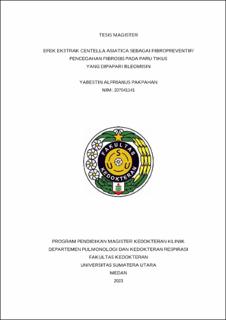| dc.description.abstract | Background: Pulmonary fibrosis is an accumulation of excessive extracellular matrix (ECM) protein as a response to repair damaged tissue due to injury from the interaction of inflammatory cells, fibroblasts, and parenchymal cells that can result in tissue damage and loss of lung function. The incidence of pulmonary fibrosis in developed countries such as the United States varies between 6.8-8.8 per 100,000 population per year which increases with increasing age. Several factors that play a role in the occurrence of pulmonary fibrosis due to bleomycin therapy, namely the presence of oxidative stress, deactivation of the bleomycin-hydrolase enzyme, damage to genetic material, and the release of inflammatory cytokines. Previous studies have shown that previous studies have shown that bleomycin can stimulate endothelial cells, macrophages, and fibroblasts to induce inflammatory mediators, then these mediators secrete proinflammatory, fibrogenic cytokines, transforming growth factor-β (TGF-β), apoptosis, and release free radicals. The asiatic acid content in gotu kola has been shown to inhibit the activity of Angiotensin Converting Enzyme (ACE) and the expression of TGF-beta. The asiatic acid content in gotu kola has been shown to inhibit the activity of Angiotensin Converting Enzyme (ACE) and the expression of TGF-beta. Both are major factors in the formation of fibrosis in the heart. Aim: To determine the effectiveness of centella asiatica extract in rat pulmonary fibrosis in bleomycin induction from a histopathological point of view. Methods: This study used an analytical study with a randomized in vivo experimental design on 3 groups of rats. The sample size in this study was 15 individuals. Data collection was carried out based on the results of histological analysis of the lung samples of rats. Results: From a total of 15 study samples divided into 3 groups, the results showed that there was no significant difference in the histopathological appearance of the alveoli (p=0.444; p=0.444) and interalveolar septum (p=0.524; p=0.524) between group K with P1 and P2. Likewise, in the interalveolar septum by TM staining there was also no significant difference between groups K with P1 and P2 (p=0.421; p=0.421). Conclusion: Doses of centella asiatica extract of 400 mg and 800 mg were not proven to be effective in preventing pulmonary fibrosis in rats induced by 4 mg/kg BW bleomycin. | en_US |


